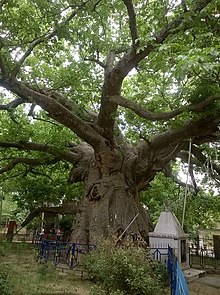


The Parijaat tree is a sacred baobab tree in the village of Kintoor, near Barabanki, Uttar Pradesh, India, about which there are several legends.[1][2]
It is a protected tree situated in Barabanki district of Uttar Pradesh, India. By the order of local district magistrate, any kind of damage to the tree is strictly prohibited. The tree is known as baobab in modern science which is originated in Sub-sahara Africa and hence its presence in the fertile land of India makes it rare. Also the age of the tree is still not determined, which makes it quite possible that the tree may have been planted by someone who used to travel between India and Africa. The tree needs international attention of scientists to find out more about it. The tree is also known as 'the tree from paradise' due to its mythological significance.
Ancient facts[edit]
Kintur, about 38 kilometres (24 mi) east of the district headquarters, Barabanki, was named after Kunti, mother of the Pandavas. There are a number ancient temples and their remains around this place. Near a temple established by Kunti, is a special tree called Parijaat which is said to grow from Kunti's ashes.[3] The radiocarbon date in 2019 of the oldest samples was 793±37 BP for the baobab of Kintoor. The corresponding calibrated age is 775±25 calendar years.[4]
There are a number of legends about this tree which have popular acceptance. One being that Arjun brought this tree from heavens and Kunti used to offer and crown Lord Shiva with its flowers. Another saying being, that Lord Krishna brought this tree for his beloved queen Satyabhama or Rukmini.[5] Historically, though these saying may have some bearing or not, but it is true that this tree is from a very ancient background.[6]
According to the Harivansh Puraan the Parijaat Tree is a Kalpavriksha, or wish bearing tree, which, apart from this tree, is only found in heaven.[2] Newly-weds visit the tree for blessings, and every Tuesday a fair is held where local people worship the tree. In Sikhism's Sukhmani Sahib the tree is mentioned "PaarJaat Eh Har Ko Naam The name of Lord is the mythological tree"[7]
References[edit]
- ^ "Parijaat Tree | District Barabanki, Government of Uttar Pradesh | India".
- ^ a b Wickens, Gerald E.; Pat Lowe (2008). The Baobabs: Pachycauls of Africa, Madagascar and Australia. Springer Science+Business Media. p. 61. ISBN 978-1-4020-6430-2.
- ^ Kameshwar, G. (2006). Bend in the Sarayu: a soota chronicle. Rupa & Co. p. 159. ISBN 978-81-291-0942-2.
- ^ Patrut A, Garg A, Woodborne S, Patrut RT, Rakosy L, Ratiu IA, et al. (2020). "Radiocarbon dating of two old African baobabs from India". PLOS ONE. 15 (1): e0227352. Bibcode:2020PLoSO..1527352P. doi:10.1371/journal.pone.0227352. PMC 6964888. PMID 31945077.
- ^ "Experts to save ancient Parijat tree". The Times of India. 26 October 2010. Archived from the original on 3 November 2012. Retrieved 26 October 2010.
- ^ Uttar Pradesh District Gazetteers: Bara Banki. Government of Uttar Pradesh. 1993. p. 21. OCLC 7625267.
- ^ "Tree From Paradise". Indiatimes. Archived from the original on 6 March 2005. Retrieved 27 November 2009.